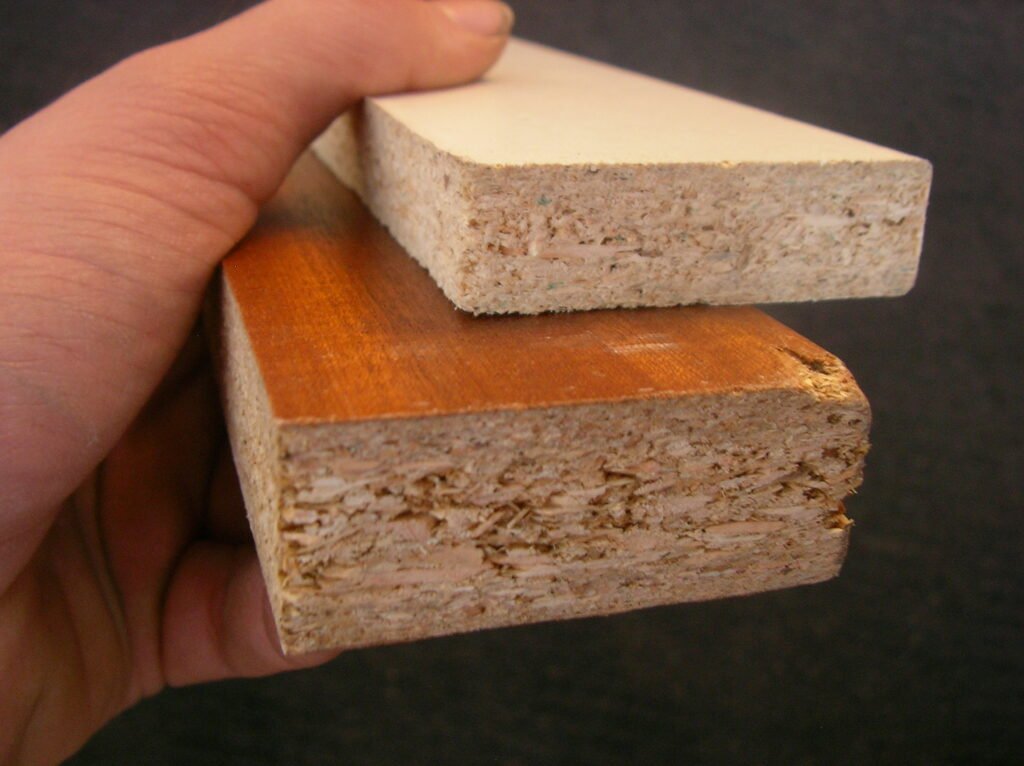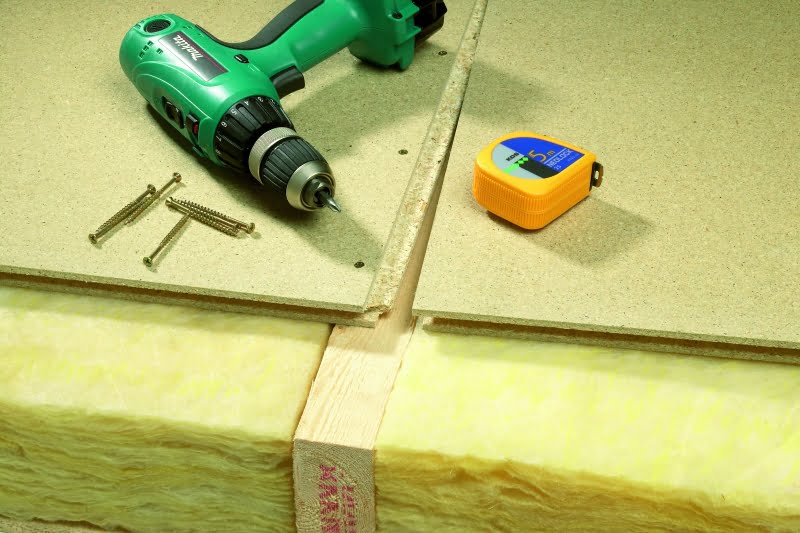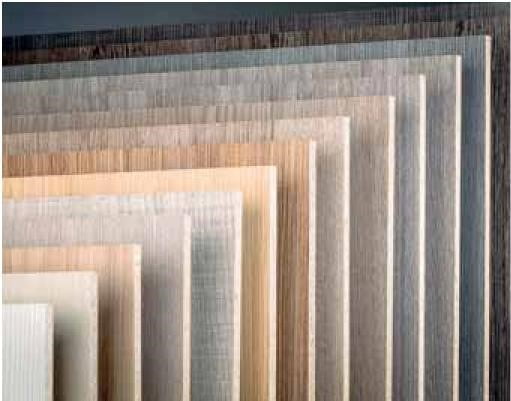Particle board
Particle board is made by compressing wood chips with glue. In flat-pressed particle board, the chips are mainly parallel to the surface. The chips in the surface layer are thinner than those in the middle layer, so the surface of the particle board is denser and more compact than the middle.
In standard particle board, urea formaldehyde is mainly used as glue. The amount of glue in a particle board is 10%, and many coated board products are classified in surface material emissions class M1. Material classification includes the limit values for the emissions of building materials meant for interiors, as well as their classification. Class M1 contains emissions-tested materials, whose emissions of impurities are within the most stringent requirements.
In terms of its basic properties, particle board is comparable to wood. It also has the following benefits, owing to its method of manufacture:
- no grain direction
- particle board is homogeneous and has the same degree of strength in different directions.
- the dynamics of the board in the direction of the plane surface is slight.
The density of particle board varies between 650 and 750 kg/m³, so it is considerably heavier than sawn conifer timber.
Particle board quality classes
Particle boards are classified into seven different classes based on their properties. The properties of particle board classes are determined in accordance with the pan-European SFS-EN 312 standard. Particle board classes are expressed using the letter ’P’ and a number.
Particle board standards do not set requirements for the quality of the board’s surface, but manufacturers categorise the board into A- and B qualities based on its appearance. When determining the quality of the surface, factors to be borne in mind include the quality of the finish, the smoothness and cleanliness of the surface and faults on the edges.
Class | Application | User class |
P1 | Construction boards for interior use | 1 |
P2 | Furniture boards for interior use | 1 |
P3 | Non-load-bearing use, a board that withstands moisture better than standard particle board | 2 |
P4 | Boards that can withstand stress, for interior use | 1 |
P5 | For applications that need to withstand stress, a board that withstands moisture better than standard particle board | 2 |
P6 | Floor boards that can withstand severe stress, for interior use | 1 |
P7 | For applications that need to withstand severe stress, a board that withstands moisture better than standard particle board | 2 |
Standard particle boards are uncoated particle boards meant for furniture manufacture and construction. The resistance to moisture of particle boards belonging to classes P3, P5 and P7 is significantly improved by using melamine-reinforced adhesive in the manufacture of the board.
Downstream products for particle boards
Downstream products made of particle board are chiefly boards made for a specific purpose and coated and machined in different ways, depending on the application.
Particle board can be coated with many different surface materials, for example veneer, melamine, laminate, plastic, paper, etc. The boards are usually coated on both sides in order to prevent warping. Boards are also made already primed for painting (treated with filler at the factory or coated with priming paper). The fire-resistance properties of particle board can be improved with alkyd filler or melamine coating.
Coated and primed particle board is used in almost the same applications as standard particle board. The coatings improve not only the surface properties of the board but also its rigidity and strength. The most common type of coated particle board is that with a melamine surface. Tongued and grooved particle boards are used in wall, ceiling and floor lining for interior spaces.
The most common board sizes for tongued and grooved particle boards meant for wall and ceiling lining are 600 x 2,600 or 2,750 mm and 1,200 x 2,600 or 2,750 mm with a thickness of 12 mm. The tongue and groove is usually on the long sides of the boards, and the boards are usually ready primed.
Floor boards are tongued and grooved all round. The most common board sizes are 600 x 2400 mm and 1200 x 2400 mm with a thickness of 22 mm.
Most common uses for quality classes for particle board in construction
From a point of view of fire-resistance, particle boards are combustible building materials. Uncoated particle board can meet the class requirements of D-s2 and d2, and coated (smooth-surfaced) particle board can meet the requirements of C-s2 and d1.
Floors
Before installation, the boards are aired for 5-7 days, as close as possible to their final conditions of use. When the boards are installed, the temperature and relative humidity in the building should be close to the future conditions of use.
Timber-framed particle board floor
In a timber-framed particle board floor, all-round tongued and grooved particle boards (thickness usually 22 mm) are fitted on top of the timber frame of the base or intermediate floor. The gap between beams must not exceed 600 mm, and the boards are fitted with the long sides crosswise in relation to the floor beams. The short sides and joints of the boards are positioned at the location of the beams. The board are attached to each beam/support, both with screws or nails and with glue. The boards are also glued to the adjacent boards at the location of their tongue and grooves. When installing the boards, a gap of about 10 mm is left between them and the surrounding walls and other structures. When installing the boards, the following instructions must be observed:
- the boards are attached to the beams with hot-galvanised 75 mm twist nails or screws, with a length 2½-3 times the thickness of the board
- the heads of the nails and screws must be sunk to a depth of 2-3 mm, and the holes where the heads are must not be filled
- the distance between nails and screws at the edge of the board is 150-200 mm and, in the centre of the board, 250-300 mm
- PVAc glue is used as an adhesive
Floating particle board floor
In a floating particle board floor, all-round tongued and grooved particle boards (thickness usually 22 mm) are fitted on top of an isolating layer. The actual load-bearing structure of the floor may be, for example, wood or concrete. The boards are glued together to form an integrated surface at the tongues and grooves, with a gap of about 10 mm left between them and the surrounding walls and other structures. The pressure required for glueing is achieved using wedges next to the surrounding walls. The wedges are removed once the glue has dried. The isolating layer used under the boards may be styrox, polyurethane, porous wood fibre board or sufficiently rigid mineral wool. When using foam plastic material, it is advisable to fit a plastic film between the foam plastic and the particle board.
Covering a particle board floor
A particle board floor can be covered with normal floor covering. When installing the covering, the product-specific instructions issued by the floor covering supplier must be observed. Before installing the covering, it is advisable to carry out the following preliminary work:
- roughness on the surface of the board is sanded down and smoothed over using purpose-made filler – if necessary further filling or priming is done, if an adhesive plastic mat is being used as the covering
- the particle board floor is allowed to dry to almost its future conditions of use before the covering is fitted
- before the floor covering is fitted, loose dirt and possible stains in holes should be removed from the surface of the board
Composite structure
A composite structure uses 22 mm-thick tongued and grooved particle board as a base board for base or intermediate floors, on top of which a fibre-reinforced concrete slab approx. 45 mm thick is cast. Before the concrete slab is cast, the particle board is brushed with a moisture sealant, and bonding nails that strengthen the bond between the board and the concrete are attached to it. This solution enables a rigid floor structure that is well insulated against airborne noise. It also enables underfloor heating and is suitable for wet rooms where the necessary floor gradients can be created when the concrete is cast.
Interior lining
Particle board is very suitable for the interior lining of wall and ceiling surfaces that require painting. Standard particle boards 10, 11 or 12 mm thick or particle board tongued and grooved along its long sides are most commonly used for wall and ceiling lining. Tongued and grooved boards usually have a bevel at the edge, forming a smallish V-shaped groove at the seam of the tongue and groove. The boards in question are also available primed or coated with priming paper.
Matters to be taken into account in interior lining:
It is advisable to use particle board lining in dry interior premises that have heating. As a wood-based material, the equilibrium moisture content of particle board changes as the relative humidity in the surrounding air changes, which causes the board to ‘live’ in the direction of its surface, to a certain extent. This must be borne in mind in the design of wall structures and the installation of boards.
Particle board walls or ceilings that require painting should be made with visible exposed joints. A suitable joint width is 3-5 mm. The V-groove joint that forms on tongued and grooved boards does not require other measures. In the corners of rooms, however, an exposed joint of 3-5 mm must also then be left.
The recommended spans in the installation of particle board are:
- 300 mm, when the board thickness is 6-8 mm (ceilings)
- 600 mm, when the board thickness is 9-8 mm
When using 600 mm-wide tongued and grooved board, attachment to the wall frame takes place by nailing (for example, with a compressed air nail gun) from the tongue and from the edges of board left under the skirting board and cornice strips. Then the seams of the boards do not need to be handled separately and the nail heads do not need to be filled. 1,200 mm-wide boards are also attached from the centre (at the load-bearing column), where the nail- or screw heads are sunk into the board by about 1 mm and filled. The tongue and groove joints of the boards and the gap between the board and the load-bearing column are strengthened with adhesive (PVAc glue) at the time of installation.
Ordering
When ordering particle boards, the following information should be given:
- thickness as a nominal thickness (mm)
- board size (mm x mm)
- board type (e.g. P6) and surface quality according to application
- for coated particle boards either the product name or the quality of the covering of both surfaces, the methods of protecting the edges (or edge battening) and colour.
Storage
During transportation and storage, the boards are protected from wetness, dirt, ground contact, dents and scratches. The boards are stored face down on a flat base. If necessary, supporting timber can be used at intervals of 0.5 metres. A pile of boards is covered with a protective sheet.
Before installation, particle boards should be aired for 5-7 days, as close as possible to their final conditions of moisture and temperature. When being aired, the boards are kept apart from each other using separating strips, and stacked against a wall, for example.
Working and machining
Particle boards can be worked using all tools suitable for working with wood. A table-mounted or portable circular saw, for example, is suitable for sawing the boards. Smaller sawing jobs can also be done with a regular hand saw. Contour sawing can be done with a jig saw.
Fastening
The length of nails used to fasten particle boards should be at least three times the thickness of the board, but no less than 30 mm, and the length of screws at least 2½ times the thickness of the board, but no less than 25 mm. The boards are fastened at intervals of 100-200 mm on each side and 200-300 mm at the centre. The distance of the fasteners from the edge of the board is about 10 mm.
Surface treatment
Particle boards can be painted, wallpapered and laminated. All general products meant for the interior painting of wooden surfaces are suitable for painting the boards.
Painting
The painting of untreated standard particle board requires priming, in which the surface of the board is painted with one thin coat of white unthinned interior primer. Nail or screw heads that remain visible are filled and dried and then sanded to a smooth finish. 1-2 coats of finishing painting are applied using the desired colour. When using ready primed boards, surface painting alone is sufficient. Rolling is the best way to apply the paint.
Wallpapering
Nail or screw heads that remain visible are filled and dried and then sanded to a smooth finish. Board joints are filled with elastic sealing strip. Once the glue has dried, the joints are filled and sanded to a smooth finish. Wallpapering is done according to the instructions of the wallpaper manufacturer. At the corners, the sheets of wallpaper should not overlap.
The re-use and disposal of particle board
Re-use
If the boards are intact and dry, particle boards may be used again on a case-by-case basis. Re-use is the most popular was of ’disposing of’ particle boards.
Disposal
Because particle board is mainly clean natural wood, it can be disposed of (in accordance with local environmental authority guidelines) by burying it in the ground, composting, taking to landfill or burning at a temperature of more than 800 C with other wood material.
Instructions and examples of the use of particle board
Particle board is also very suitable for building furniture on-site, and for making different do-it-yourself products. Special countersunk screws, different kinds of mounting hardware and screws and mortise joints are suitable for putting together particle board furniture and board structures.
15-18 mm coated (e.g. melamine-coated) boards are very suitable as frame structures for particle board furniture. 22-28 mm-thick board should be used for table tops and covers. Thin 3-6 mm-thick particle board or hardboard is suitable as backing plates.
The edges of particle board that remain visible can be covered with special chafing strip, veneer or wooden batten strips. The best result is achieved by using boards that have already been coated and edged at the factory. If you want to paint the edges, they should first be covered with a paintable chafing strip or given two layers of filler and sanded.
Particle board applications
Construction
- interior lining
- floors
- concrete moulds
Construction industry
- as web plates for beams
- fixtures and fittings
- as a base material for parquet floors
- as a base material for covering strips
Furniture industry
- furniture frames
Other applications
- packaging
- exhibition and fair structures
- do-it-yourself


